GDHS微观经济学讲义
- 格式:ppt
- 大小:1.48 MB
- 文档页数:70
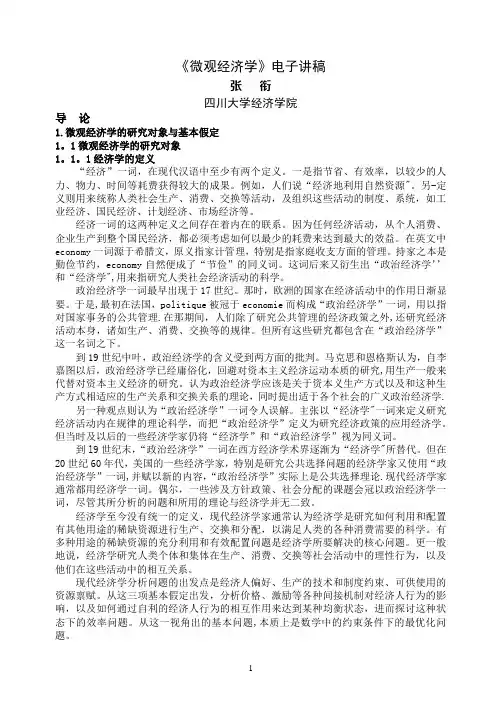
《微观经济学》电子讲稿张衔四川大学经济学院导论1.微观经济学的研究对象与基本假定1。
1微观经济学的研究对象1。
1。
1经济学的定义“经济”一词,在现代汉语中至少有两个定义。
一是指节省、有效率,以较少的人力、物力、时间等耗费获得较大的成果。
例如,人们说“经济地利用自然资源"。
另-定义则用来统称人类社会生产、消费、交换等活动,及组织这些活动的制度、系统,如工业经济、国民经济、计划经济、市场经济等。
经济一词的这两种定义之间存在着内在的联系。
因为任何经济活动,从个人消费、企业生产到整个国民经济,都必须考虑如何以最少的耗费来达到最大的效益。
在英文中economy一词源于希腊文,原义指家计管理,特别是指家庭收支方面的管理。
持家之本是勤俭节约,economy自然便成了“节俭”的同义词。
这词后来又衍生出“政治经济学’’和“经济学",用来指研究人类社会经济活动的科学。
政治经济学一词最早出现于17世纪。
那时,欧洲的国家在经济活动中的作用日渐显要。
于是,最初在法国,politique被冠于economie而构成“政治经济学”一词,用以指对国家事务的公共管理.在那期间,人们除了研究公共管理的经济政策之外,还研究经济活动本身,诸如生产、消费、交换等的规律。
但所有这些研究都包含在“政治经济学”这一名词之下。
到19世纪中叶,政治经济学的含义受到两方面的批判。
马克思和恩格斯认为,自李嘉图以后,政治经济学已经庸俗化,回避对资本主义经济运动本质的研究,用生产一般来代替对资本主义经济的研究。
认为政治经济学应该是关于资本义生产方式以及和这种生产方式相适应的生产关系和交换关系的理论,同时提出适于各个社会的广义政治经济学.另一种观点则认为“政治经济学”一词令人误解。
主张以“经济学"一词来定义研究经济活动内在规律的理论科学,而把“政治经济学”定义为研究经济政策的应用经济学。
但当时及以后的一些经济学家仍将“经济学”和“政治经济学”视为同义词。
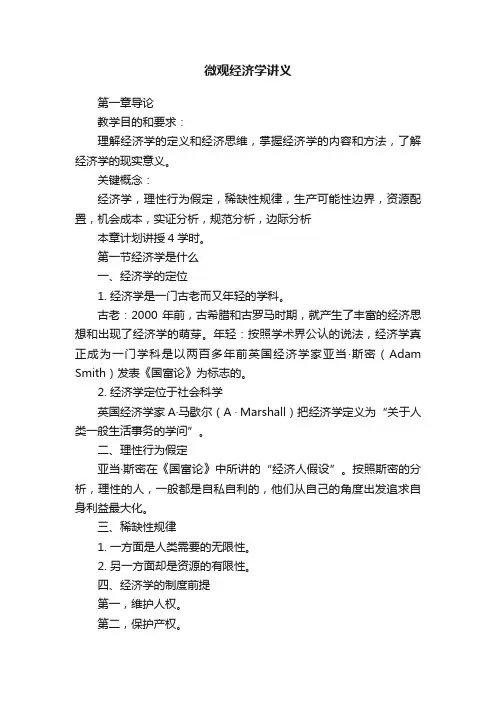
微观经济学讲义第一章导论教学目的和要求:理解经济学的定义和经济思维,掌握经济学的内容和方法,了解经济学的现实意义。
关键概念:经济学,理性行为假定,稀缺性规律,生产可能性边界,资源配置,机会成本,实证分析,规范分析,边际分析本章计划讲授4学时。
第一节经济学是什么一、经济学的定位1. 经济学是一门古老而又年轻的学科。
古老:2000年前,古希腊和古罗马时期,就产生了丰富的经济思想和出现了经济学的萌芽。
年轻:按照学术界公认的说法,经济学真正成为一门学科是以两百多年前英国经济学家亚当·斯密(Adam Smith)发表《国富论》为标志的。
2. 经济学定位于社会科学英国经济学家A·马歇尔(A · Marshall)把经济学定义为“关于人类一般生活事务的学问”。
二、理性行为假定亚当·斯密在《国富论》中所讲的“经济人假设”。
按照斯密的分析,理性的人,一般都是自私自利的,他们从自己的角度出发追求自身利益最大化。
三、稀缺性规律1. 一方面是人类需要的无限性。
2. 另一方面却是资源的有限性。
四、经济学的制度前提第一,维护人权。
第二,保护产权。
第三,理性政府。
第二节经济学的基本问题一、资源配置资源配置解决以下三大基本经济问题:1.生产什么?2.如何生产?3.为谁生产?二、资源利用资源利用问题就是要解决好如下三大基本经济问题:1.社会的生产能力为什么有时会倒退?2.如何才能不断地扩张社会的生产能力?3.谁来协调全社会的生产的稳定和发展?三、微观经济学与宏观经济学经济学按其研究的内容,可以分为微观经济学和宏观经济学。
微观经济学强调的是资源的配置,而宏观经济学强调的是资源的利用。
第三节经济学的研究方法一、实证分析与规范分析1.什么是实证分析?实证分析企图超脱或者排斥一切的价值判断,只考虑建立经济事物之间的关系,并在这些规律的作用下,分析和预测人们经济行为的结果。
简单地说,实证分析要回答的是“是什么”的问题。


微观经济学教案主讲:柳治国目录第一章导言第一节(西方)经济学涵义第二节经济学的研究对象第三节经济学的十大原理第四节微观经济学的研究方法第五节(西方)经济学的由来和演变第二章供求理论第一节需求第二节供给第三节均衡价格和价格机制第三章弹性理论第一节需求价格弹性第二节其他弹性第四章消费者行为理论第一节欲望与效用第二节边际效用分析法第三节无差异分析法第五章生产理论第一节生产与生产函数第二节一种要素的合理投入第三节多种要素的合理投入(1):规模经济第四节多种要素的合理投入(2):最佳组合第六章成本与收益第一节成本函数分析第二节几个重要的成本概念第三节收益与利润最大法原则第七章厂商均衡理论第一节完全竞争条件下的厂商均衡第二节完全垄断条件下的厂商均衡第三节垄断竞争条件下的企业行为模式第四节寡头垄断市场条件下企业行为模式第八章分配理论第一节分配的基本原理第二节工资第三节利息第四节地租第五节利润第六节收入分配均等程度的度量第九章市场失灵与微观经济政策第一章导论第一节(西方)经济学涵义教学重点:介绍经济学的定义教学难点:西方经济学与政治经济学的区别与联系教学方法:讲授法,比较法教学安排:2课时教学过程:一、(西方)经济学的定义经济学是一门实践性的社会科学,内容博大庞杂,分支众多,研究者阵营强大,因而难以有标准的定义。
这里给出若干定义,以见其内涵。
1.定义一:经济学是研究国民财富生产的。
( 亚当·斯密)2.定义二:经济学是研究人类日常生活事物的科学。
(阿尔弗雷德·马歇尔)3.定义三:经济学是对经济理论的研究和考察。
4.定义四:经济学是“研究如何利用稀缺的资源以生产有价值的商品,并将它们分配给不同的个人”的科学(萨谬尔森)。
5.其他含义:“企事业的经营管理方法和经验,对某一经济部门或问题的集中研究成果。
”二、经济学是一门理论科学1.经济科学是一个庞大的学科体系科学分为理论学科和应用学科,如物理学与各种工程技术学。
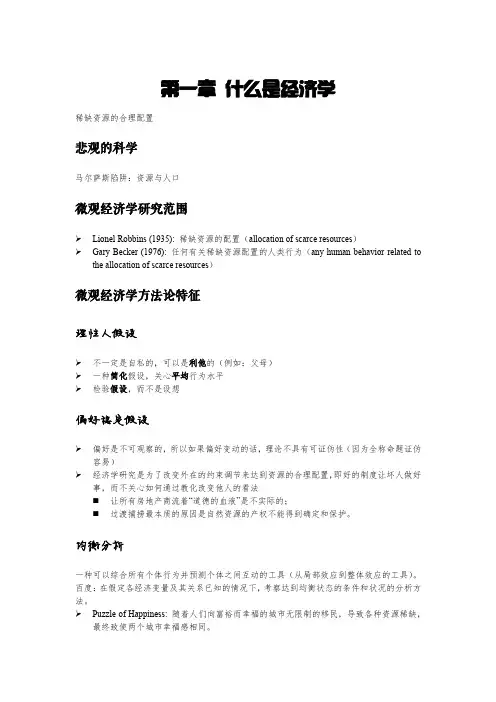


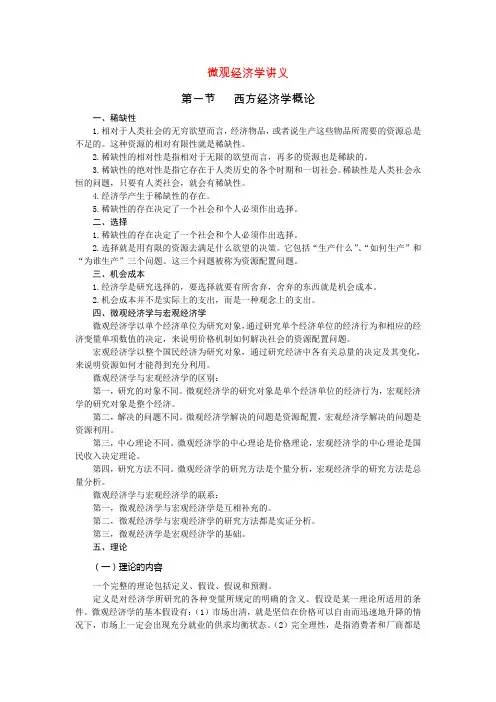
微观经济学讲义第一节西方经济学概论一、稀缺性1.相对于人类社会的无穷欲望而言,经济物品,或者说生产这些物品所需要的资源总是不足的。
这种资源的相对有限性就是稀缺性。
2.稀缺性的相对性是指相对于无限的欲望而言,再多的资源也是稀缺的。
3.稀缺性的绝对性是指它存在于人类历史的各个时期和一切社会。
稀缺性是人类社会永恒的问题,只要有人类社会,就会有稀缺性。
4.经济学产生于稀缺性的存在。
5.稀缺性的存在决定了一个社会和个人必须作出选择。
二、选择1.稀缺性的存在决定了一个社会和个人必须作出选择。
2.选择就是用有限的资源去满足什么欲望的决策。
它包括“生产什么”、“如何生产”和“为谁生产”三个问题。
这三个问题被称为资源配置问题。
三、机会成本1.经济学是研究选择的,要选择就要有所舍弃,舍弃的东西就是机会成本。
2.机会成本并不是实际上的支出,而是一种观念上的支出。
四、微观经济学与宏观经济学微观经济学以单个经济单位为研究对象,通过研究单个经济单位的经济行为和相应的经济变量单项数值的决定,来说明价格机制如何解决社会的资源配置问题。
宏观经济学以整个国民经济为研究对象,通过研究经济中各有关总量的决定及其变化,来说明资源如何才能得到充分利用。
微观经济学与宏观经济学的区别:第一,研究的对象不同。
微观经济学的研究对象是单个经济单位的经济行为,宏观经济学的研究对象是整个经济。
第二,解决的问题不同。
微观经济学解决的问题是资源配置,宏观经济学解决的问题是资源利用。
第三,中心理论不同。
微观经济学的中心理论是价格理论,宏观经济学的中心理论是国民收入决定理论。
第四,研究方法不同。
微观经济学的研究方法是个量分析,宏观经济学的研究方法是总量分析。
微观经济学与宏观经济学的联系:第一,微观经济学与宏观经济学是互相补充的。
第二,微观经济学与宏观经济学的研究方法都是实证分析。
第三,微观经济学是宏观经济学的基础。
五、理论(一)理论的内容一个完整的理论包括定义、假设、假说和预测。
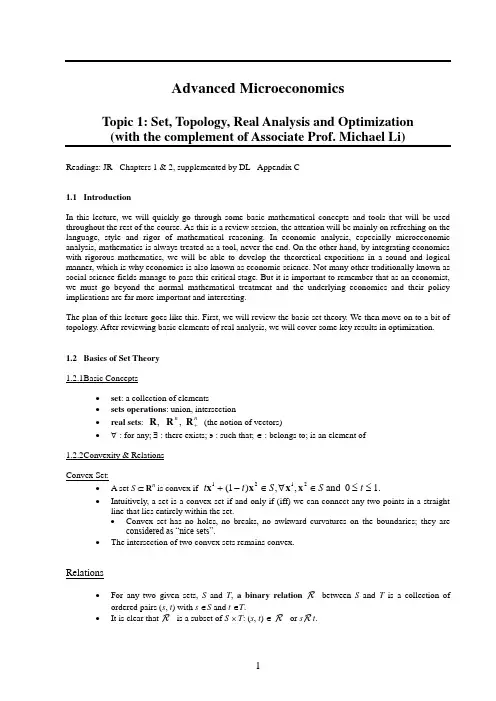
Advanced MicroeconomicsTopic 1: Set, Topology, Real Analysis and Optimization Readings: JR - Chapters 1 & 2, supplemented by DL - Appendix C1.1 IntroductionIn this lecture, we will quickly go through some basic mathematical concepts and tools that will be used throughout the rest of the course. As this is a review session, the attention will be mainly on refreshing on the language, style and rigor of mathematical reasoning. In economic analysis, especially microeconomic analysis, mathematics is always treated as a tool, never the end. On the other hand, by integrating economics with rigorous mathematics, we will be able to develop the theoretical expositions in a sound and logical manner, which is why economics is also known as economic science. Not many other traditionally known as social science fields manage to pass this critical stage. But it is important to remember that as an economist, we must go beyond the normal mathematical treatment and the underlying economics and their policy implications are far more important and interesting.The plan of this lecture goes like this. First, we will review the basic set theory. We then move on to a bit of topology. After reviewing basic elements of real analysis, we will cover some key results in optimization.1.2 Basics of Set Theory 1.2.1 B asic Concepts∙ set : a collection of elements∙ sets operations : union, intersection ∙ real sets : n n +R R R , , (the notion of vectors)∙ ∀ : for any; ∃ : there exists; ∍ : such that; ∈ : belongs to; is an element of1.2.2 C onvexity & RelationsConvex Set:∙ A set S ⊂ R n is convex if .10 and ,,)1(2121≤≤∈∀∈-+t S S t t x x x x∙ Intuitively, a set is a convex set if and only if (iff) we can connect any two points in a straightline that lies entirely within the set.∙ Convex set has no holes, no breaks, no awkward curvatures on the boundaries; they areconsidered as “nice sets”.∙ The intersection of two convex sets remains convex.Relations∙ For any two given sets, S and T , a binary relation R between S and T is a collection ofordered pairs (s , t ) with s ∈S and t ∈T .∙ It is clear that R is a subset of S ⨯ T : (s , t ) ∈ R or s R t .Properties of Relations :∙ Completeness∙ R ⊂ S ⨯ S is complete iff for all x and y (x ≠ y ) in S , x R y or y R x .∙ Reflexivity∙ R ⊂ S ⨯ S is reflexive if for all x in S , x R x .∙ Transitivity∙ R ⊂ S ⨯ S is transitive if for all x, y, z in S , x R y and y R z implies x R z .1.3 TopologyTopology attempts to study the fundamental properties of sets and mappings. Our discussion will be mainly on the real space R n .∙ A real topological space is normally denoted as (R n , d ), where d is the metric defined on thereal space. Intuitively speaking, d is a distance measure between two points in the real space. ∙ Euclidean spaces are special real topological spaces associated with the Euclidean metricdefined as follows:n n n x x x x x x d R x x x x x x ∈∀-++-+-=-=2122122212221112121,;)()()(||||),(1.3.1 S ets on a Real Topological Spaceε-Balls∙ Open ε-Ball for a point x 0: for ε > 0,}),(|{)(00εε<∈≡x x R x x d B n∙ Closed ε-Ball for a point x 0: for ε > 0,}),(|{)(00εε≤∈≡x x R x x d B nOpen Sets∙ S ⊂ R n is open set if, ∀ x ∈ S , ∃ ε > 0 such that (∍) B ε(x ) ⊂ S . ∙ Properties of Open Sets:∙ The empty set and the whole set are open set∙ Union of open sets is open; intersection of open sets is open too. ∙ Any open set can be represented as a union of open balls:)(x x x εB S S∈= , where S B ⊂)(x x ε.Closed Sets∙ S is a closed set if its complement, S c , is an open set.∙ A point x ∈S is an interior point if there is some ε-ball centered at x that is entirely containedin S . The collection of all interior points of S is denoted by int S , known as the interior of S .∙ Properties of Closed Sets:∙ The empty set and the whole set are closed;∙ Union of any finite collection of closed sets is a closed set; ∙ Intersection of closed sets is a closed set.Compact Sets∙ A set S is bounded if ∃ ε > 0 such that (∍): S ⊂ B ε(x ) for some x ∈ S . ∙ A set in R n that is closed and bounded is called a compact set .1.3.2 F unctions/Mappings on R n∙ Let D ⊂ R m , f : D → R n . We say f is continuous at the point x 0 ∈D if∀ ε > 0, ∃ δ > 0 ∍ ))(())((00x x f B D B f εδ⊂⋂∙ Special Case: D ⊂ R , f : D → R . f is continuous at x 0 ∈D if ∀ ε > 0, ∃ δ > 0 ∍ δε<-∈<-|| and whenever ,|)()(|00x x D x x f x fProperties of Continuous Mappings:∙ Let D ⊂ R m , f : D → R n . Then∙ f is continuous ⇔ for all open ball B ⊂ R n , f --1(B ) is open in D⇔ for all open set S ⊂ R n , f --1(S ) is open in D∙ If S ⊂ D is compact (closed and bounded), then its image f (S ) is compact in R n .1.3.3 W eierstrass Theorem & The Brouwer Fixed-Point TheoremThese two theorems, known as existence theorems , are very important in microeconomic theory. “An existence theorem” specifies conditions that, if met, something exists . In the meantime, please keep in mind that the conditions in the existence theorems are normally sufficient conditions , meaning that if the required conditions are NOT met, it does not mean the nonexistence of something – it may still exist. The existence theorems say very little about exact location of this something . In other words, existence theorems are powerful tools for showing that something is there; but it is not sufficient in actually finding the equilibrium.Weierstrass Theorem – Existence of Extreme Values∙ This is a fundamental result in optimization theory .∙ (Weierstrass Theorem ) Let f : S ⊂ R be a continuous real-valued mapping where S is a nonemptycompact subset of R n . Then a global maximum and a global minimum exist, namely,.),~()()( that such ~,**S f f f S S ∈∀≤≤∈∈∃x x x x x xThe Brouwer Fixed-Point TheoremMany profound questions about the fundamental consistency of microeconomic systems have been answered by reformulating the question as one of the existence of a fixed point. Examples include:∙ The view of a competitive economy as a system of interrelated markets is logically consistentwith this setting;∙ The well-known Minimax Theorem in game theory∙ (Brouwer Fixed-Point Theorem ) Let S ⊂ R n be a nonempty compact and convex set. Let f : S→ S be continuous mapping. Then there exists at least one fixed point of f in S . That is, ∃ x * ∈S such that x * = f (x *).1.4 Real-Valued Functions∙ By definition, a real-valued function is a mapping from an arbitrary set D (domain set ) of R n to a subsetR of the real line R (range set ).∙ f : D → R , with D ⊂ R n & R ⊂ R.Increasing/Decreasing Functions:∙ Increasing function : f (x 0) ≥ f (x 1) whenever x 0 ≥ x 1;∙ Strictly increasing function : f (x 0) > f (x 1) whenever x 0 > x 1;∙ Strongly increasing function : f (x 0) > f (x 1) whenever x 0 ≠ x 1 and x 0 ≥ x 1∙ Similarly, we can define the three types of decreasing functions.Concavity of Real-Valued Functions∙ Assumption f : D → R , with D ⊂ R n is convex subset of R n & R ⊂ R.∙ f : D → R is concave if for all x 1, x 2 ∈ D ,]1 ,0[),()1()())1((2121∈∀-+≥-+t f t tf t t f x x x x∙ Intuitively speaking, a function is concave iff for every pair of points on its graph, the chordbetween them lies on or below the graph.∙ f : D → R is strict concave if for all x 1≠ x 2 in D ,)1 ,0(),()1()())1((2121∈∀-+>-+t f t tf t t f x x x x∙ f : D → R is quasiconcave if for all x 1, x 2 ∈ D ,]1 ,0[)],(),(min[))1((2121∈∀≥-+t f f t t f x x x x∙ f : D → R is strictly quasiconcave if for all x 1≠ x 2 in D ,)1 ,0()],(),(min[))1((2121∈∀>-+t f f t t f x x x xConvexity of Real-Valued Functions∙ After the discussion of concave functions, we can take care of the convex functions by taking thenegative of a concave function.∙ f : D → R is convex if for all x 1, x 2 ∈ D ,]1 ,0[),()1()())1((2121∈∀-+≤-+t f t tf t t f x x x x∙ f : D → R is strict convex if for all x 1≠ x 2 in D ,)1 ,0(),()1()())1((2121∈∀-+<-+t f t tf t t f x x x x∙ f : D → R is quasiconvex if for all x 1, x 2 ∈ D ,]1 ,0[)],(),(min[))1((2121∈∀≤-+t f f t t f x x x x∙ f : D → R is strictly quasiconvex if for all x 1≠ x 2 in D ,)1 ,0()],(),(min[))1((2121∈∀<-+t f f t t f x x x xProperties of Concave/Convex Functions∙ f : D → R is concave ⇔ the set of points beneath the graph, i.e., {(x , y )| x ∈ D , f (x ) ≥ y } is a convexset.∙ f : D → R is convex ⇔ the set of points above the graph, i.e., {(x , y )| x ∈ D , f (x ) ≤ y } is a convex set. ∙ f : D → R is quasiconcave ⇔ superior sets, i.e., {x | x ∈ D , f (x ) ≥ y } are convex for all y ∈ R . ∙ f : D → R is quasiconvex ⇔ inferior sets, i.e., {x | x ∈ D , f (x ) ≤y } are convex for all y ∈ R .∙ If f is concave/convex ⇒ f is quasiconcave/quasiconvex;∙ f (strictly) concave/quasiconcave ⇔ -f (strictly) convex/quasiconvex.∙ Let f be a real-valued function defined on a convex subset D of R n with a nonempty interior on which f isa twice differentiable function, then the following statements are equivalent: ∙ If f is concave.∙ The Hessian matrix H (x ) is negative semidefinite for all x in D . ∙ For all x 0 ∈ D , f (x ) ≤ f (x 0) + ∇ f (x 0) (x – x 0), ∀ x ∈ D .Homogeneous Functions∙ A real-valued function f (x ) is called homogeneous of degree k if0 all for )()(>=t f t t f k x x .Properties of Homogeneous Functions:∙ f is homogeneous of degree k , its partial derivatives are homogeneous of degree k – 1. ∙ (Euler’s Theorem) f (x ) is homogeneous of degree k iff. all for )()(1x x x ∑=∂∂=ni i ix x f kf1.5 Introduction to Optimization∙ We will focus on real-valued functions only.Main Concepts of Optima∙ Local minimum/maximum ∙ Global minimum/maximum∙ Interior maxima, boundary maxima 1.5.1 U nconstrained OptimizationFirst-Order (Necessary) Condition for Local Interior Optima∙ If the differentiable function f (x ) reaches on a local interior maximum or minimum at x *, then x *solves the system of simultaneous equations:∇ f (x *) = 0.Second-Order (Necessary) Condition for Local Interior OptimaLet f (x ) be twice differentiable.1. If f (x ) reaches a local interior maximum at x *, then H (x *) is negative semidefinite.2. If f (x ) reaches a local interior minimum at x *, then H (x *) is positive semidefinite.Notes:∙ There is a simple method in checking whether a matrix is a negative (positive) semidefinte,which is to examine the signs of the determinants of the principle minors for the given matrix.Local-Global Optimization Theorem∙ For a twice continuously differentiable real-valued concave function f on D , the following threestatements are equivalent, where x* is an interior point of D : 1. ∇ f (x*) = 0.2. f achieves a local maximum at x*.3. f achieves a global maximum at x*.Strict Concavity/Convexity and Uniqueness of Global Optima∙ If x * maximizes the strictly concave (convex) function f , then x * is the unique global maximizer(minimizer).1.5.2 C onstrained OptimizationThe Lagrangian MethodConsider the following optimization problem:m j g f j n,,1,0)( subject to )(max ==∈x x RxNote:∙ If the objective function f is real-valued and differentiable, and if the constraint set defined bythe constraint equations is compact, then according to Weierstrass Theorem, optima of the objective function over the constraint set do exist.To solve this, we form the Lagrangian by multiplying each constraint equation g i by a different Lagrangian multiplier λj and adding them all to the objective function f . Namely,∑=+=mj j j g f L 1).()(),(x x Λx λLagrange’s TheoremLet f and g j be continuously differentiable real-valued function over some D ⊂ R n . Let x * be an interior point of D and suppose that x * is an optimum (maximum or minimum) of f subject to the constraints, g j (x *) = 0, j = 1, …, m . If the gradient vectors, ∇ g j (x *), j = 1, …, m , are linearly independent, then there exist m unique numbers λ, j = 1,…, m , such that.,...,1for 0 )()(),(1**n i x g x f x L m j ij j i i ==∂∂+∂∂=∂Λ∂∑=x x x λSpecial Case: Graphical InterpretationConsider the special case: max f (x 1, x 2) subject to g (x 1, x 2) = 0.As our primary interest is to solve the problem for x 1, x 2, then the Lagrangian condition becomes:21212211*x g x g x f x f x g x f x g x f ∂∂∂∂-=∂∂∂∂-⇒∂∂∂∂-=∂∂∂-=λ which is what we commonly known as tangency condition . To see this, define the level set as follows:L (y 0) = {(x 1, x 2) | f (x 1, x 2) = y 0}.and refer the diagram below.Second-Order Condition & Bordered HessianFor ease of discussion, let us focus the special case: max f (x 1, x 2) subject to g (x 1, x 2) = 0. Assume that there is a (curve) solution to the constraint, namely, x 2 = x 2(x 1), such thatg (x 1, x 2(x 1)) = 0Lettingy = f (x 1, x 2(x 1))be the value of the objective function subject to the constraint.∙ As a function of single variable, the second-order (sufficient) condition for a maximum/minimum is thatthe second-order derivative of y with respect to x 1 is negative (concave) or positive (convex).∙ This second-order derivative is associated with the determinant of the following matrix, known asbordered Hessian of the Lagrange function L :⎪⎪⎪⎭⎫ ⎝⎛=0212222111211g g g L L g L L H ∙ In particular, we have the following relationship:22212)()1(g D dx y d -= where D is the determinant of the bordered Hessian, i.e.,])(2)([0212221122211212222111211g L g g L g L g g g L L g L L D +--== ∙ The above discussion can be extended to the general case.Inequality ConstraintsLet f (x ) be continuously differentiable.∙ If x* maximizes f (x ) subject to x ≥ 0, then x satisfies:ni x n i x f x n i x f i i i i ,...,1 ,0,...,1 ,0*)(,...,1 ,0*)(**=≥==⎥⎦⎤⎢⎣⎡∂∂=≤∂∂x x∙ If x* mimimizes f (x ) subject to x ≥ 0, then x satisfies:ni x n i x f x n i x f i i i i ,...,1 ,0,...,1 ,0*)(,...,1 ,0*)(**=≥==⎥⎦⎤⎢⎣⎡∂∂=≥∂∂x xKuhn-Tucker Conditions(Kuhn-Tucker) Necessary Conditions for Optima of Real-Valued Functions Subject to Inequality Constraints:Let f (x ) and g j (x ), j = 1,…,m , be continuously differentiable real-valued functions over some domain D ⊂ R n . Let x * be an interior point of D and suppose that x * is an optimum (maximum or maximum) of f subject to the constraints, g j (x ) ≥ 0, j = 1,…,m .If the gradient vectors ∇ g j (x*) associated with all binding constraints are linearly independent, then there exists a unique vector Λ* such that (x*, Λ*) satisfies the Kuhn-Tucker conditions:.,...,1 0*)( ,0*)( ,...,1 0*)(*)(*)*,(*1*m j g g ni x g x f L j j j m j i j j i i =≥===∂∂+∂∂≡Λ∑=x x x x x λλ Furthermore, the vector Λ* is nonnegative if x* is a maximum, and nonpositive if it is a minimum.1.5.3 V alue FunctionsConsider the following parameterized optimization problem:max {x } f (x, a ) subject to g (x, a ) = 0 and x ≥ 0.where x is a vector of choice variables, and a = (a 1, …, a m ) is a vector of parameters that may enter the objective function, the constraint, or both.∙ Suppose that for each a , there is a unique solution denoted by x(a).∙ Define the value function M (a ) = f (x(a), a ), which is the optimal value of the objective functionassociated with a .The Envelope TheoremConsider the same optimization problem as identified above. For each a , let x(a). > 0 uniquely solve the problem. Assume that the objective function and the constraints are continuously differentiable in the parameters a . Let L (x,a,λ) be the problem's associated Lagrangian function and let (x(a), λ(a )) solve the Kuhn-Tucker conditions. And let M (a ) be the problem's associated maximum-value function. Then, the Envelope Theorem states that.,...,1 )()(),(m j a La M jj =∂∂=∂∂a a x a λNote:∙ The theorem says that the total effect on the optimized value of the objective function when aparameter changes (and so, presumably, the whole problem must be reoptimized) can bededuced simply by taking the partial of the problem's Lagarangian with respect to the parameter and then evaluating that derivative at the solution to the original problem's first-order Kuhn-Tucker conditions.The theorem applies to cases having many constraints.。


微观经济学讲义整理思维方式: 得到结论的过程远比结论本身重要第一章 绪论1-1, 什么是经济学经济学是研究个人和团体从事生产、交换以及对产品和服务消费的一种社会科学,它研究如何样最佳使用稀缺的资源以满足人们无限的需求。
1-2, 经济学的差不多研究方法能够分为以下四种:个量与总量分析法,静态与动态分析法, 定性与定量分析法, 实证与规范分析法1-3, 实证经济学(Positive Economics )是用理论对社会各种经济活动或经济现象进行说明、分析、证实或推测。
第二章 需求、供给与均衡价格理论2-1,需求曲线在一样情形下是一条负斜率的曲线,即从左上向右下倾斜,这是需求曲线的差不多特点,两个缘故:低价会吸引更多的购买者,从而使需求量增加低价会使同一个购买者对该商品的购买量增加,而减少对其他类似(可替代)商品的购买2-2,收入效应 ( income effect ): 价格降低等于收入增加2-3,替代效应 ( substitution effect ): 商品的替代作用2-4,阻碍需求变化的“其他条件”:消费者的收入消费者的偏好 ( taste )消费者对商品价格和收入前景的预期其他商品的价格两种商品为替代品 ( substitute goods ); 两种商品为互补品 ( complement goods )2-5,供给曲线在一样情形下是一条正斜率的曲线,即从左下向右上倾斜,这是供给曲线的差不多特点。
这说明:价格越高,生产者越情愿供给产品,因此,供给数量一样随价格升降而增减。
2-6,阻碍供给变化的“其他条件”:▪ 生产要素的价格▪ 生产技术▪ 商品市场生产厂商的数量▪ 其他商品的价格▪ 政府的税收和扶持政策▪ 生产者对商品以后行情的预期2-7,市场均衡模型的含义是:假如市场价格背离均衡价格,就有自动复原到均衡点并连续保持均衡的趋势 2-8,当供给量大于需求量时,称为“过量供给”(excess quantity supplied )或“过剩”(surplus )2-10,当需求量大于供给量时,称为“过量需求”(excess quantity demanded )或“短缺”(shortage )2-11, 当供给量等于需求量时,称为“供求均衡”2-12, 市场机制中价格有以下三点作用:▪ 传达信息的作用▪ 分配稀缺资源的作用▪ 决定收入水平的作用2-13,八种全部的变化可能综合反映在同一张图上第三章 弹性理论需求弹性包括:需求价格弹性,需求收入弹性,需求交叉弹性3-1, 弹性:因变量变化的百分比同自变量变化的百分比之间的比例关系弹性系数 3-2, 需求价格弹性 ( price elasticity of demand ) :是需求量的变动对价格变动的敏锐程度 YX X Y X Y •∆∆=∆∆=X Y e P Q Q Q ∆∆3-3, 弧弹性运算方法 :为幸免由于起始点基数值的不同而造成运算结果上的差异,经济学上常采取按两点的平均数值运算的方法 ,按这种方法所求出的弹性称为“弧弹性” (arc elasticity)3-4,点弹性:指在某一价格水平点上,当价格波动专门微小的一点,所引起的需求量变化的敏锐程度。